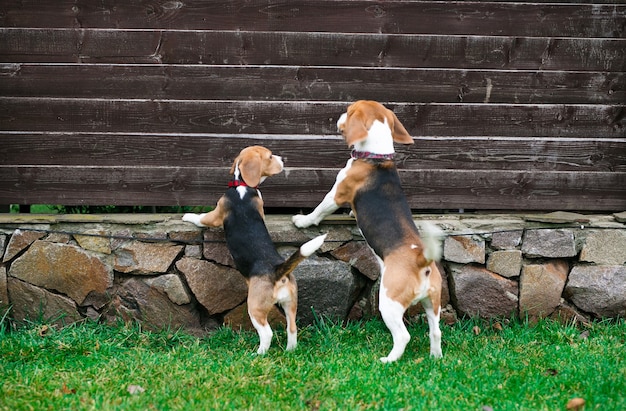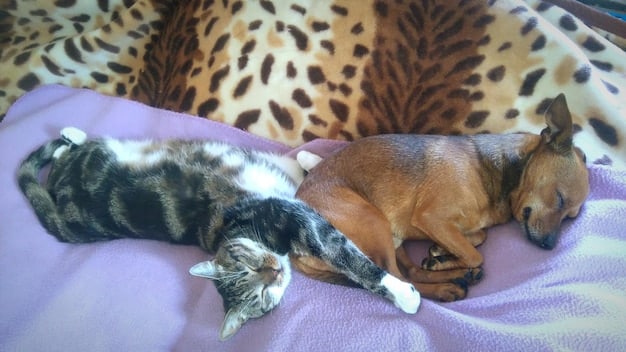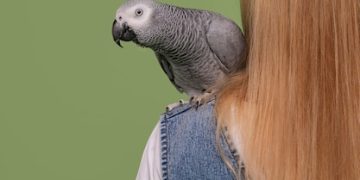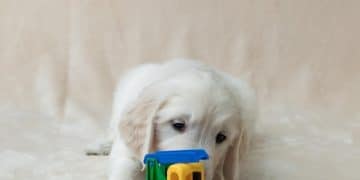A Step-by-Step Guide: How to Introduce a New Pet to Your Existing Animals

Introducing a new pet to existing animals requires a gradual integration plan, focusing on scent exchange, supervised meetings, and positive reinforcement to ensure a harmonious and stress-free environment for all pets involved.
Bringing a new pet into your home is an exciting time, but it’s crucial to understand how to introduce a new pet to your existing animals: a gradual integration plan is essential for minimizing stress and ensuring a peaceful coexistence. This guide will walk you through a step-by-step approach to successfully integrate your new furry or feathered friend into the family.
Why a Gradual Introduction Matters
Introducing a new pet to your existing animals isn’t as simple as opening the door and hoping for the best. A slow and controlled introduction process is vital for the well-being of all the animals involved. It allows them to adjust to each other’s presence gradually, reducing the risk of fear, anxiety, and aggression.
Reducing Stress and Anxiety
Sudden introductions can be overwhelming for pets. Existing pets may feel their territory is being invaded, leading to defensive behaviors. New pets may be frightened by unfamiliar surroundings and established residents. A gradual approach helps alleviate these anxieties by allowing pets to adjust at their own pace.
Preventing Aggression
Rushing the introduction can lead to fights and injuries. By taking things slowly, you give your pets the opportunity to learn to tolerate, and eventually accept, each other. This is particularly important for animals with strong territorial instincts or a history of aggression.
Building Positive Associations
A gradual introduction allows you to create positive associations between your pets. By pairing their interactions with treats, praise, and positive experiences, you can help them develop a friendly relationship. This approach sets the stage for a harmonious household.

In conclusion, a thoughtful and gradual integration strategy is essential for the successful introduction of a new pet, fostering a respectful and calm environment that minimizes stress and strengthens relationships for all creatures in your house.
Preparing for the Introduction
Before your new pet even sets paw, claw, or fin into your home, preparation is key. Ensuring both your existing pets and your new arrival have their needs met independently will pave the way for smoother interactions down the line. This initial stage focuses on setting up separate spaces and managing resources to minimize potential conflicts.
Separate Living Spaces
- Designate separate areas for each animal. This includes separate food and water bowls, beds, and litter boxes (for cats).
- Ensure each animal has a safe and comfortable space where they can retreat without being disturbed.
- Keep your new pet confined to their designated area initially. This allows your existing pets to adjust to their presence without direct contact.
Scent Exchange
Scent is a powerful form of communication for animals. Before introducing them visually, exchange their scents to help them become familiar with each other.
- Swap bedding or towels between their sleeping areas.
- Rub a cloth on one animal and then on the other to transfer their scents.
- Allow them to sniff under the door separating their spaces.
Resource Management
Competition over resources can lead to aggression. Ensure each animal has their own set of toys, food bowls, and water bowls to avoid conflicts.
- Feed your pets separately, either in different rooms or at different times.
- Provide plenty of toys and enrichment items to keep them occupied and prevent boredom.
- Avoid leaving high-value items (like bones or favorite toys) unsupervised during initial interactions.
Getting this preparation correct establishes a strong base for future positive interactions by providing a controlled environment that gradually introduces each animal to the existence of the other, laying the groundwork for a less stressful transition time.
The First Meeting: Supervised Interactions
Once your pets have had time to adjust to each other’s scents, it’s time to introduce them visually. These initial meetings should be highly supervised and carefully controlled to prevent any negative interactions, and setting up the environment may be crucial to success.
Controlled Environment
Choose a neutral area for the first meeting, such as a hallway or living room. Avoid areas where either animal feels particularly territorial.
Keep your new pet on a leash or in a carrier during the initial meeting. This allows you to control their movements and prevent them from approaching your existing pet too quickly.
Brief Interactions
Keep the first meeting short and sweet. A few minutes is enough to allow them to see each other and assess the situation. End the meeting on a positive note, before either animal becomes stressed or agitated.
Positive Reinforcement
Use treats, praise, and positive reinforcement to create positive associations during the meeting. Reward calm and friendly behavior.
If either animal shows signs of stress or aggression, separate them immediately and try again later with a shorter and more controlled meeting.
By maintaining a controlled environment and utilizing positive reinforcement techniques, the first meeting can set a good tone for upcoming interactions, fostering an atmosphere of curiosity and security for all interacting animals.
Gradually Increasing Interaction Time
After several successful supervised meetings, you can begin to gradually increase the amount of time your pets spend together. This should be done slowly and incrementally, always under your supervision.
Short, Supervised Play Sessions
Allow your pets to play together for short periods while you supervise. Use toys to distract them and encourage positive interactions.
Feeding Time Together
Feed your pets their meals in the same room, but at a safe distance from each other. This helps them associate each other’s presence with a positive experience (food).
Monitoring Body Language
Pay close attention to your pets’ body language during interactions. Look for signs of stress, such as flattened ears, tucked tails, or growling. If you see these signs, separate them immediately.
It’s important to understand that every animal is different, and some animals may require additional time to adjust to each other. It is important to remain patient and adaptable; proceed with caution, and adjust your strategy as necessary to ensure a positive adjustment is maintained.

Addressing Challenges and Setbacks
Even with a gradual introduction plan, challenges and setbacks can occur. It’s important to be prepared to address these issues and adjust your approach as needed.
Signs of Stress and Anxiety
- Hiding or retreating
- Loss of appetite
- Excessive vocalization (meowing, barking, etc.)
- Changes in litter box habits (for cats)
Dealing with Aggression
If your pets exhibit aggressive behaviors, such as growling, hissing, or biting, separate them immediately.
- Consult with a veterinarian or certified animal behaviorist to determine the underlying cause of the aggression.
- Consider using a muzzle or other protective gear during supervised interactions.
- Do not punish your pets for aggressive behavior. This can worsen the problem and damage your relationship with them.
Adjusting the Pace
If you encounter challenges, slow down the introduction process. Go back to an earlier stage, such as scent exchange, and spend more time allowing your pets to adjust to each other’s presence.
Being able to identify and properly address difficulties helps to guarantee that you can respond effectively, reducing stress and encouraging a good outcome for all of your pets.
Long-Term Harmony: Maintaining a Peaceful Household
Once your pets have successfully integrated, it’s important to maintain a peaceful and harmonious household. This involves continuing to provide separate resources, monitoring their interactions, and addressing any emerging issues promptly.
Continued Supervision
Even after your pets seem comfortable together, continue to supervise their interactions, especially during feeding time or when high-value items are present.
Reinforcing Positive Behaviors
Continue to reward positive interactions with treats, praise, and attention. This reinforces their friendly relationship and prevents relapses.
Addressing Resource Guarding
If one pet shows signs of resource guarding (protecting food, toys, or space), separate them immediately and consult with a veterinarian or animal behaviorist.
By putting in place plans for long-term care, you can keep a peaceful cohabitation, cultivating a happy and healthy atmosphere for all of your furry or feathered companions.
| Key Point | Brief Description |
|---|---|
| 👃 Scent Exchange | Introduce pets to each other’s scents before visual contact to reduce anxiety. |
| 🐾 Supervised Meetings | Conduct initial visual meetings in a controlled environment, keeping interactions brief. |
| 🦴 Resource Management | Provide separate resources (food, toys) to prevent competition and aggression. |
| 😊 Positive Reinforcement | Use treats and praise to reward calm and friendly behavior during interactions. |
Frequently Asked Questions (FAQ)
▼
The introduction process can take anywhere from a few days to several weeks, depending on the personalities of the animals involved. Proceed at their pace and be patient.
▼
In some cases, pets may never become best friends, but they can learn to tolerate each other. Continue to provide separate spaces and monitor their interactions.
▼
It’s best to continue supervising their interactions, especially during feeding time or when high-value items are present, to prevent any potential conflicts.
▼
Introduce your new pet to one animal at a time, starting with the most docile or least territorial pet. This can help prevent overwhelming your new pet and reduce the risk of conflicts.
▼
If you’re struggling to introduce your pets successfully or if they exhibit aggressive behaviors, consult with a veterinarian or a certified animal behaviorist for guidance. Early intervention can help improve outcomes.
Conclusion
Successfully integrating a new pet into a household with existing animals requires patience, understanding, and a gradual approach. By following these steps and carefully monitoring your pets’ interactions, you can create a harmonious environment where everyone can thrive. Always prioritize the safety and well-being of all your furry, scaly, or feathered family members.





